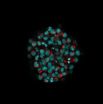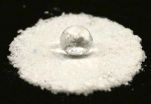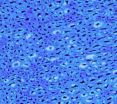(Press-News.org) Lighter, more flexible, and cheaper than conventional solar-cell materials, carbon nanotubes (CNTs) have long shown promise for photovoltaics. But research stalled when CNTs proved to be inefficient, converting far less sunlight into power than other methods.
Now a research team led by Mark Hersam, professor of materials science and engineering and the Bette and Neison Harris Chair of Teaching Excellence at Northwestern University's McCormick School of Engineering, has created a new type of CNT solar cell that is twice as efficient as its predecessors. It is also the first CNT solar cell to have its performance certified by the National Renewable Energy Laboratory.
"The field had been hovering around 1 percent efficiency for about a decade; it had really plateaued," Hersam said. "But we've been able to increase it to over 3 percent. It's a significant jump."
The research is described in the article "Polychiral Semiconducting Carbon Nanotube-Fullerene Solar Cells" in the August 7 issue of Nano Letters.
The secret lies in the CNTs' chirality, which is a combination of the tubes' diameter and twist. When a thin sheet of carbon is rolled into a nanotube, several hundred different chiralities are possible. In the past, researchers tended to choose one particular chirality with good semiconducting properties and build an entire solar cell out of that one.
"The problem is that each nanotube chirality only absorbs a narrow range of optical wavelengths," Hersam said. "If you make a solar cell out of a single chirality carbon nanotube, you basically throw away most of the solar light."
Hersam's team made a mixture of polychiral, or multiple chirality, semiconducting nanotubes. This maximized the amount of photocurrent produced by absorbing a broader range of solar-spectrum wavelengths. The cells significantly absorbed near-infrared wavelengths, a range that has been inaccessible to many leading thin-film technologies.
While this is major progress for CNT solar cells, they still lag behind other materials in efficiency. Silicon, for example, can be 15-20 percent efficient, but it is more expensive to manufacture. "If you look at our performance, there's certainly a big jump," Hersam said. "But there's more work to be done. We still have to advance this technology by a factor of three to five."
Hersam said the next step is to create polychiral CNT solar cells that have multiple layers. Each layer would be optimized for a particular portion of the solar spectrum and, thus, absorb more light. He said they might also incorporate other materials, such as organic or inorganic semiconductors, to complement CNTs.
"What we'd like to do is absorb every photon from the sun and convert it into electricity," he said. "In other words, we'd like to have a solar cell that has an absorption spectrum perfectly matching solar light. We're on a path toward that goal."
INFORMATION: END
Breakthrough for carbon nanotube solar cells
Polychiral carbon nanotube mixture absorbs more sunlight
2014-09-03
ELSE PRESS RELEASES FROM THIS DATE:
Ethanol fireplaces: The underestimated risk
2014-09-03
Go to the DIY-market in the morning, buy the fireplace, and that evening, enjoy the cozy warmth and homey atmosphere of your new ornamental hearth. The suppliers of ethanol fireplaces are doing a brisk business with the lightweight, easy-to-install ornamental stoves with no chimney. However, caution is warranted when operating these fireplaces, because ethanol is a fuel that, together with the air, forms a highly combustible atmospheric mixture. If ethanol runs out when filling the combustion chambers and it ignites, then the entire room could go up in flames.
On top ...
Fingerprints for freight items
2014-09-03
Thousands of freight items are shipped by plane every day, around seventy percent of them in airliners. Stringent controls are supposed to prevent hazardous substances such as explosives from being smuggled on board. Screening procedures, such as x-ray scanning of freight, are time consuming and costly and have to be repeated in the event of suspicious circumstances. Easily verifiable features that verify that a freight item is "secure" have been lacking until now.
Researchers at the Fraunhofer Institute for Factory Operation and Automation IFF in Magdeburg are working ...
A 'clear' choice for clearing 3-D cell cultures
2014-09-03
VIDEO:
Using a confocal microscope, researchers can study a cleared spherical 3-D tissue culture at any depth. The video begins on the near surface and exits on the far side of...
Click here for more information.
PROVIDENCE, R.I. [Brown University] — Because Brown University biomedical engineering graduate student Molly Boutin needed to study how neural tissues grow from stem cells, she wanted to grow not just a cell culture, but a sphere-shaped one. Cells grow and interact ...
Parrots go to carpentry school
2014-09-03
This news release is available in German.
Scientists from Oxford University, the University of Vienna, and the Max Planck Institute at Seewiesen have shown that a spontaneous innovation by a Goffin's cockatoo can spread to other conspecifics by social learning.
After observing that an adult male Goffin cockatoo named Figaro spontaneously started to sculpt stick tools out of wooden aviary beams and used them for raking in nuts behind grit, the researchers wondered what effect, if any, such an individual technical invention might have on social companions. They used ...
Grooving crystal surfaces repel water
2014-09-03
Researchers from Kyoto University in Japan have developed a novel way to waterproof new functionalized materials involved in gas storage and separation by adding exterior surface grooves. Their study, published in the journal Angewandte Chemie, provides a blueprint for researchers to build similar materials involved in industrial applications, such as high performance gas separation and energy storage.
The materials, also known as porous coordination polymers (PCPs), are hollow nanoscale cage-like structures with the ability to house molecules within their empty ...
New discovery could help turn antibiotic into antimalarial drug
2014-09-03
Melbourne researchers are making progress towards new antimalarial drugs, after revealing how an antibiotic called emetine blocks the molecular machinery that produces the proteins required for malaria parasite survival.
Although emetine is effective against malaria it is not used as a preventive drug due to its significant side effects. However, the work of Walter and Eliza Hall Institute researchers Dr Wilson Wong, Dr Jake Baum and colleagues in showing how emetine attaches to and blocks the molecular machinery that makes the proteins required for malaria parasite survival ...
Sensory reinnervation of muscle spindles after TN defect repaired by autologous vein graft
2014-09-03
After complete transection of a nerve, good neuroanastomosis is needed to prevent the formation of fibrous connective tissues that form obstacles to nerve regeneration, and to facilitate repair of the injured nerve and reinnervation of its original targets. Peripheral nerve defects of more than 10 mm are commonly treated in clinics, and in these injuries a conduit is needed to bridge the gap, prevent the formation of obstacles to nerve regeneration, and guide axonal regrowth. Autogenous vein grafts have been used extensively for the repair of nerve defects in rats. Motor ...
Puerarin accelerates neural regeneration after sciatic nerve injury
2014-09-03
Puerarin is a natural isoflavone isolated from plants of the genus Pueraria and functions as a protector against cerebral ischemia. Can puerarin be involved in the repair of peripheral nerve injuries? Minfei Wu and co-workers from the Second Hospital of Jilin University in China verified that puerarin exerts an ongoing role to activate growth-associated protein 43 in the corresponding segment of the spinal cord after sciatic nerve injury, thus contributing to neural regeneration after sciatic nerve injuries. Their relevant study has been reported in the Neural Regeneration ...
Researchers demonstrate direct brain-to-brain communication in human subjects
2014-09-03
BOSTON –In a first-of-its-kind study, an international team of neuroscientists and robotics engineers have demonstrated the viability of direct brain-to-brain communication in humans. Recently published in PLOS ONE the highly novel findings describe the successful transmission of information via the internet between the intact scalps of two human subjects – located 5,000 miles apart.
"We wanted to find out if one could communicate directly between two people by reading out the brain activity from one person and injecting brain activity into the second person, and do ...
Wind energy cuts the electricity bill
2014-09-03
This news release is available in Spanish.
The UPV/EHU study analyses the electricity market in Spain during the 2008-2012 period -a time of maximum renewable penetration in Spain when energy production within the Special Scheme saw a 57% increase- and quantifies its cost.
To do this, they firstly measured the market savings produced by participating in renewable sources, and secondly, they calculated the amount paid in the form of incentives to green energy. The difference between the two figures represents the net cost of renewable energy. In contrast to other ...
LAST 30 PRESS RELEASES:
Decoupling the HOR enhancement on PtRu: Dynamically matching interfacial water to reaction coordinates
Sulfur isn’t poisonous when it synergistically acts with phosphine in olefins hydroformylation
URI researchers uncover molecular mechanisms behind speciation in corals
Chitin based carbon aerogel offers a cleaner way to store thermal energy
Tracing hidden sources of nitrate pollution in rapidly changing rural urban landscapes
Viruses on plastic pollution may quietly accelerate the spread of antibiotic resistance
Three UH Rainbow Babies & Children’s faculty elected to prestigious American Pediatric Society
Tunnel resilience models unveiled to aid post-earthquake recovery
Satellite communication systems: the future of 5G/6G connectivity
Space computing power networks: a new frontier for satellite technologies
Experiments advance potential of protein that makes hydrogen sulfide as a therapeutic target for Alzheimer’s disease
Examining private equity’s role in fertility care
Current Molecular Pharmacology achieves a landmark: real-time CiteScore advances to 7.2
Skeletal muscle epigenetic clocks developed using postmortem tissue from an Asian population
Estimating unemployment rates with social media data
Climate policies can backfire by eroding “green” values, study finds
Too much screen time too soon? A*STAR study links infant screen exposure to brain changes and teen anxiety
Global psychiatry mourns Professor Dan Stein, visionary who transformed mental health science across Africa and beyond
KIST develops eco-friendly palladium recovery technology to safeguard resource security
Statins significantly reduce mortality risk for adults with diabetes, regardless of cardiovascular risk
Brain immune cells may drive more damage in females than males with Alzheimer’s
Evidence-based recommendations empower clinicians to manage epilepsy in pregnancy
Fungus turns bark beetles’ defenses against them
There are new antivirals being tested for herpesviruses. Scientists now know how they work
CDI scientist, colleagues author review of global burden of fungus Candida auris
How does stroke influence speech comprehension?
B cells transiently unlock their plasticity, risking lymphoma development
Advanced AI dodel predicts spoken language outcomes in deaf children after cochlear implants
Multimodal imaging-based cerebral blood flow prediction model development in simulated microgravity
Accelerated streaming subgraph matching framework is faster, more robust, and scalable
[Press-News.org] Breakthrough for carbon nanotube solar cellsPolychiral carbon nanotube mixture absorbs more sunlight







